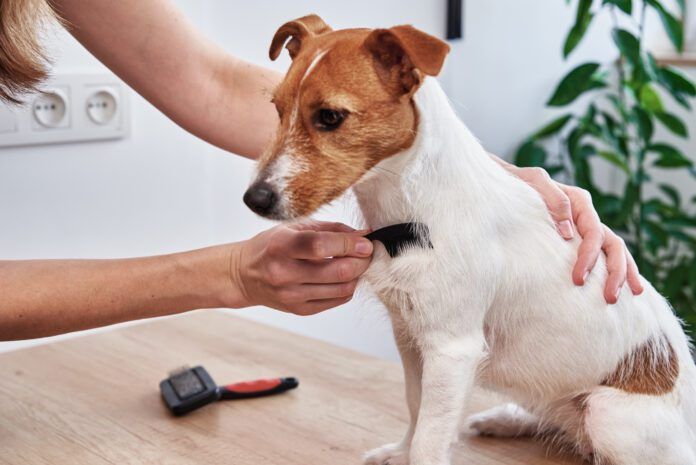In my career, it has happened more times than I can count. I’m finishing up with a dog’s wellness exam and the pet parent asks, “By the way, my dog has dry skin. What do you think about it?”
My follow-up question is always, “When did you first notice it?”
More times than not the answer is, “Just now, I mean, I just gave her a bath yesterday and now look at her.”
Some shedding of skin dead skin cells is normal and usually not noticed, but most dogs I see in clinical practice have dry, flaky skin secondary to another condition.
Conservative Remedies for Dry Skin on a Dog
If your dog is otherwise healthy and you haven’t noticed any other signs, the dog’s symptoms are most likely mild and possibly transient. That means some conservative remedies for a dog with dry skin may be worth a try:
- Brush the dog regularly. If the dog’s hair is matted or shedding hair is not brushed out, dry flakes can become trapped close to the skin. Brushing the haircoat with a brush appropriate for your dog’s type of coat can help stimulate the healthy oils in the skin. At first, the dry skin may appear worse than you previously noted, but that’s likely because you have freed up the flakes.
- Choose the right shampoo. My pet parent in this scenario said that the dog just received a bath. Dog shampoo can dry the skin, so increasing the time between shampoos, and making sure to use a shampoo appropriate for that dog, can help. For example, if a dog just rolled in something that smells bad, they don’t need a medicated shampoo meant to de-grease the coat. You can also apply a dog-specific conditioner after the shampoo. With both shampoo and conditioner, make sure you follow any label instructions about how long to leave the product on, as contact time is often very important.
- Feed a quality dog food. Good nutrition and adequate hydration are important to healthy skin. Feeding a good quality, nutritionally balanced diet is the place to start. Many pet food brands now have products within their line dedicated to healthy skin/coat.
- Add omega-3 fatty acids to their diet. If you are feeding a diet that already claims to be high in omega-3s, you may want to consult your veterinarian before supplementing further. If you are not using a diet high in omega-3s, use a reputable branded dog product and follow label instructions or consult your veterinarian for dosing if considering a human product.
- Encourage your dog to drink water. To encourage good water consumption in dogs, start with making sure there is adequate fresh, clean water available. Change the water daily and clean the bowl. If your pet gets a dry kibble, adding a little water to the kibble or even soaking the kibble so that it absorbs the water can help. Canned food contains a large amount of water, so supplementing with or completely switching to a canned food diet will often result in more overall water consumption. Do not force your dog to drink water. You want to encourage him.
- Consider a humidifier. If you’re in an environment of low humidity, which can happen in many homes over the colder months, consider a humidifier for areas where the dog spends most of its time.
Dog’s Dry Skin Is Due to Disease
If your dog’s dry skin is significant enough to cause you to make a veterinary appointment or your veterinarian catches it at a wellness visit, it’s time to look at other scenarios that can cause symptoms that may look like dry skin. It is important to have your dog seen by their veterinarian if the dry skin is more than mild or has been persistent or progressive or the dog has other symptoms. Causes may include:
- These are parasites that live on the outside of the dog such as fleas, mites, and lice, which can contribute to the appearance of dry skin because they disrupt normal skin health. In addition, the mite Cheyletiella is sometimes referred to as “the walking dandruff mite” because it can look like dandruff to the naked eye. In my experience, Cheyletiella is most common in puppies (and kittens) from places where large numbers of pets have lived together in poor husbandry. The good news is that most products that kill fleas should kill this mite, so if you pet is on a highly effective flea control product this is not likely to be the cause of your pet’s dry skin.
- Bacteria and fungi. These skin infections can cause the appearance of flakes on the skin, although sometimes it is not just scales of dry skin but also crusts that owners mistake as dry skin. In these cases, treating the infection with an appropriate topical and/or systemic therapy will often resolve the skin problem. The caveat is that some of these dogs have an underlying condition that predisposes them to the infection such as allergies or a hormonal condition. In both cases, managing and treating the underlying problem will help decrease incidence of infections.
- Hormonal conditions. Low thyroid levels (hypothyroidism) and diabetes mellitus can also cause the appearance of dry skin. In these cases, correcting the hormonal imbalances by providing the missing substance such as levothyroxine in the case of hypothyroidism or insulin in the case of diabetes mellitus will help the skin issues improve or resolve. Hormonal conditions can have negative effects on other aspects of the dog’s health, so it is important to get them diagnosed and treated.
Remember that for dogs with more significant dry skin, itching, or other signs of a change in their health, an appointment for an exam with your veterinarian is in order. It is better to get the dog a medical exam before trying the list above because if the pet has another condition (like diabetes) delaying diagnosis and treatment of that condition could negatively affect your pet’s overall health.






